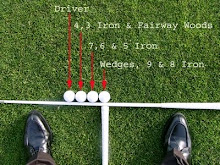Winter golf can be very different from summer golf in terms of conditioning of the golf course. Here are a couple important rules to remember to increase your enjoyment and to help the rules of golf work for you rather than against you...
Rule 25-2. Embedded Ball
A ball embedded in its own pitch-mark in the ground in any closely mown area through the green may be lifted, cleaned and dropped, without penalty, as near as possible to the spot where it lay but not nearer the hole. The ball when dropped must first strike a part of the course through the green. "Closely mown area" means any area of the course, including paths through the rough, cut to fairway height or less.
25-1. Abnormal Ground Conditions: Casual Water"Casual water" is any temporary accumulation of water on the course that is not in a water hazard and is visible before or after the player takes his stance. Snow and natural ice, other than frost, are either casual water or loose impediments, at the option of the player. Manufactured ice is an obstruction. Dew and frost are not casual water.
A ball is in casual water when it lies in or any part of it touches the casual water.
a. Interference:
Interference by an abnormal ground condition occurs when a ball lies in or touches the condition or when the condition interferes with the player's stance or the area of his intended swing. If the player's ball lies on the putting green, interference also occurs if an abnormal ground condition on the putting green intervenes on his line of putt. Otherwise, intervention on the line of play is not, of itself, interference under this Rule.
b. Relief
Except when the ball is in a water hazard or a lateral water hazard, a player may take relief from interference by an abnormal ground condition as follows:
(i)Through the Green: If the ball lies through the green, the player must lift the ball and drop it, without penalty, within one club-length of and not nearer the hole than the nearest point of relief. The nearest point of relief must not be in a hazard or on a putting green. When the ball is dropped within one club-length of the nearest point of relief, the ball must first strike a part of the course at a spot that avoids interference by the condition and is not in a hazard and not on a putting green.
(ii) In a Bunker: If the ball is in a bunker, the player must lift the ball and drop it either:
(a) Without penalty, in accordance with Clause(i) above, except that the nearest point of relief must be in the bunker and the ball must be dropped in the bunker or, if complete relief is impossible, as near as possible to the spot where the ball lay, but not nearer the hole, on a part of the course in the bunker that affords maximum available relief from the condition...
Subscribe to:
Post Comments (Atom)





No comments:
Post a Comment